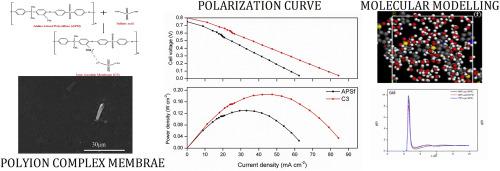当前位置:
X-MOL 学术
›
Renew. Energy
›
论文详情
Our official English website, www.x-mol.net, welcomes your
feedback! (Note: you will need to create a separate account there.)
High proton conductivity dual modified ionic crosslink membrane for fuel cell application at low humidity condition with molecular dynamics simulations
Renewable Energy ( IF 9.0 ) Pub Date : 2020-11-01 , DOI: 10.1016/j.renene.2020.06.026 Harsha Nagar , Vineet Aniya , Prasenjit Mondal
Renewable Energy ( IF 9.0 ) Pub Date : 2020-11-01 , DOI: 10.1016/j.renene.2020.06.026 Harsha Nagar , Vineet Aniya , Prasenjit Mondal

|
Abstract Dual modified ionic cross-link polysulfone (PSF) polymer-based proton-conducting membrane is synthesized with an aim to provide low methanol permeability without sacrificing the proton conductivity for direct methanol fuel cell application. The modification of pristine PSF membrane with aniline and further cross-linking by sulfuric acid was confirmed by its detailed characterization. The modified membrane achieved a high proton conductivity of 0.072 Scm−1 (30 °C) and 0.178 Scm−1 (110 °C) in low humidity condition (40%). The membrane exhibits low methanol permeability (2.5 × 10−8 cm2s−1) with high selectivity (28.4 × 105 Scm3s−1). The higher diffusivity of hydronium ion (H3O+) with an increase in hydration level and temperature was studied by molecular dynamics simulation and well agrees with experimental results in terms of proton conductivity. The reduced electrostatic interactions between the sulfonic acid group and H3O+ ion were confirmed by the radial distribution function analysis. These interaction pushes the H3O+ ion that helps in the transfer of proton by increases their coordination with water. Moreover, the high interaction of amine group with H3O+ ion also contributes to the proton conductivity enhancement. The dual modified membrane achived maximum power density of 0.19 Wcm−2 at 45 mA cm−2 and was 42% higher as compared to aniline treated polysulfone (APSF) membrane.
中文翻译:

用于燃料电池在低湿度条件下的分子动力学模拟的高质子传导性双改性离子交联膜
摘要 合成了双改性离子交联聚砜 (PSF) 聚合物基质子传导膜,目的是在不牺牲直接甲醇燃料电池应用的质子传导性的情况下提供低甲醇渗透率。用苯胺改性原始 PSF 膜并通过硫酸进一步交联通过其详细表征得到证实。改性膜在低湿度条件 (40%) 下实现了 0.072 Scm-1 (30 °C) 和 0.178 Scm-1 (110 °C) 的高质子电导率。该膜表现出低甲醇渗透率 (2.5 × 10−8 cm2s−1) 和高选择性 (28.4 × 105 Scm3s−1)。通过分子动力学模拟研究了水合水平和温度增加时水合氢离子 (H3O+) 的更高扩散率,并且在质子电导率方面与实验结果非常吻合。通过径向分布函数分析证实了磺酸基团和 H3O+ 离子之间减少的静电相互作用。这些相互作用推动 H3O+ 离子,通过增加它们与水的协调来帮助质子转移。此外,胺基与 H3O+ 离子的高相互作用也有助于提高质子电导率。与苯胺处理的聚砜 (APSF) 膜相比,双改性膜在 45 mA cm-2 下实现了 0.19 Wcm-2 的最大功率密度,并且高出 42%。通过径向分布函数分析证实了磺酸基团和 H3O+ 离子之间减少的静电相互作用。这些相互作用推动 H3O+ 离子,通过增加它们与水的协调来帮助质子转移。此外,胺基团与 H3O+ 离子的高相互作用也有助于提高质子电导率。与苯胺处理的聚砜 (APSF) 膜相比,双改性膜在 45 mA cm-2 下实现了 0.19 Wcm-2 的最大功率密度,并且高出 42%。通过径向分布函数分析证实了磺酸基团和 H3O+ 离子之间减少的静电相互作用。这些相互作用推动 H3O+ 离子,通过增加它们与水的协调来帮助质子转移。此外,胺基团与 H3O+ 离子的高相互作用也有助于提高质子电导率。与苯胺处理的聚砜 (APSF) 膜相比,双改性膜在 45 mA cm-2 下实现了 0.19 Wcm-2 的最大功率密度,并且高出 42%。
更新日期:2020-11-01
中文翻译:

用于燃料电池在低湿度条件下的分子动力学模拟的高质子传导性双改性离子交联膜
摘要 合成了双改性离子交联聚砜 (PSF) 聚合物基质子传导膜,目的是在不牺牲直接甲醇燃料电池应用的质子传导性的情况下提供低甲醇渗透率。用苯胺改性原始 PSF 膜并通过硫酸进一步交联通过其详细表征得到证实。改性膜在低湿度条件 (40%) 下实现了 0.072 Scm-1 (30 °C) 和 0.178 Scm-1 (110 °C) 的高质子电导率。该膜表现出低甲醇渗透率 (2.5 × 10−8 cm2s−1) 和高选择性 (28.4 × 105 Scm3s−1)。通过分子动力学模拟研究了水合水平和温度增加时水合氢离子 (H3O+) 的更高扩散率,并且在质子电导率方面与实验结果非常吻合。通过径向分布函数分析证实了磺酸基团和 H3O+ 离子之间减少的静电相互作用。这些相互作用推动 H3O+ 离子,通过增加它们与水的协调来帮助质子转移。此外,胺基与 H3O+ 离子的高相互作用也有助于提高质子电导率。与苯胺处理的聚砜 (APSF) 膜相比,双改性膜在 45 mA cm-2 下实现了 0.19 Wcm-2 的最大功率密度,并且高出 42%。通过径向分布函数分析证实了磺酸基团和 H3O+ 离子之间减少的静电相互作用。这些相互作用推动 H3O+ 离子,通过增加它们与水的协调来帮助质子转移。此外,胺基团与 H3O+ 离子的高相互作用也有助于提高质子电导率。与苯胺处理的聚砜 (APSF) 膜相比,双改性膜在 45 mA cm-2 下实现了 0.19 Wcm-2 的最大功率密度,并且高出 42%。通过径向分布函数分析证实了磺酸基团和 H3O+ 离子之间减少的静电相互作用。这些相互作用推动 H3O+ 离子,通过增加它们与水的协调来帮助质子转移。此外,胺基团与 H3O+ 离子的高相互作用也有助于提高质子电导率。与苯胺处理的聚砜 (APSF) 膜相比,双改性膜在 45 mA cm-2 下实现了 0.19 Wcm-2 的最大功率密度,并且高出 42%。











































 京公网安备 11010802027423号
京公网安备 11010802027423号